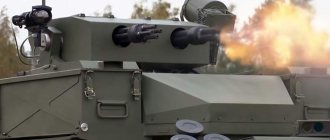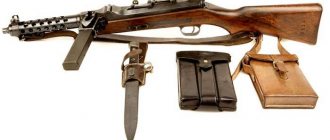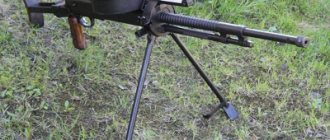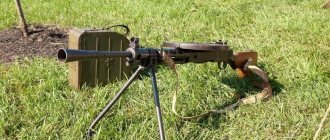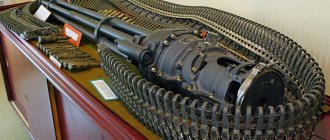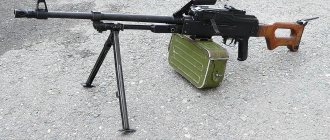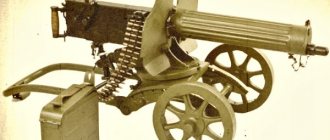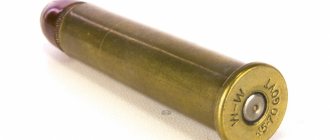In the second half of the 19th century, there were probably no weapons with such a controversial reputation. Some considered it an unreliable design that wasted ammo. And in Africa, one demonstration of Gatling machine guns to tribal leaders drove one of the leaders to suicide. The inventor developed this weapon with the most humane motives - but in the eyes of many it became terrible and “inhumane.” And certainly no one could have foreseen that this system would be in demand a century and a half after its appearance.
The Gatling machine gun is often called a “kartechnitsa” in Russian to demonstrate its differences from “real” machine guns and to emphasize the specifics of its use. And the history of this weapon began unexpectedly.
History of appearance
The Gatling gun is a figment of the imagination and hands of a man who did not have a military education, but was a certified doctor. Despite the fact that instead of saving lives, its creator intended to effectively take them, it was thanks to this weapon that he left a mark on human history. Richard Jonathan Gatling (1818-1903) had a passion for invention from a young age. Having become a certified doctor, he did not devote himself to the health of patients for long, but began to develop effective weapons. In 1862, he received his first patent for the Revolving Battery Gun. At that time, the fastest-firing weapons were revolvers and repeating rifles. Their disadvantage was the long reloading time, which had to be done after several shots. Gatling decided to create a new system that would be convenient, reliable and would not require long downtime to change cartridges.
The history of the creation of the Gatling and Gast gun
After the invention of firearms, to increase efficiency, humanity began to improve and modify them. During tests, and even in combat use, it was established that the more massive the fire is, the more effective it is and the more damage it causes to the enemy. At first they tried to increase the rate of fire due to the physical characteristics of the shooter. Everything is simple here: you equip it faster, you destroy more enemies. But they soon realized that human capabilities, unfortunately, have their limits and “you can’t jump over your head.”
Armament of the first ships
- History of ship weapons: Ram, Harpagus, Boarding
Varieties
Ship guns - history of development
Falconet - small-caliber gun
Mortar - a cannon with a short barrel
Types of cannon shells
Images
Operating principle
The first Gatling gun created a real sensation. Many could not even imagine that it was possible to solve the problem of rate of fire and reloading with such grace. The operating principle of the Gatling gun is so simple that it is surprising that the most famous gunsmiths in the world had not thought of it before. For his gun, the doctor chose a rotating cylinder as a means of feeding the next cartridge into the barrel. He brought him to the firing mechanism, which accelerated the firing of shots. The 1862 Gatling gun had 6 barrels. They were attached to a special rotor unit. 6 shutters were placed in its grooves. The Gatling gun, the design of which was elementary to the point of banality, allowed us to take a different look at the possibilities of rate of fire. When the rotor block rotated, each barrel, which had its own bolt, went through 6 stages in a circle:
- opening the shutter;
- removing the sleeve;
- sending a new cartridge;
- closing the shutter;
- Preparation;
- shot.
The Gatling machine gun, the drawings of which are available in our review, is simply amazing in its exceptional simplicity and effectiveness. That is why, even a century and a half after its invention, the military did not lose their interest in it. The Gatling machine gun can now be found in service with many armies around the world. They are installed on armored vehicles, vehicles, aircraft, ships and used manually.
Device Description
Gatling machine guns had a different number of barrels, from four to ten. Their rate of fire was approximately 200 rounds per minute, and their firing range was about 1 thousand meters. The range of machine guns was superior to the artillery guns existing at that time. "Gatlings" could have different calibers: from 12 to 40 mm.
Gatling machine guns were very bulky and heavy, so they were usually mounted on gun carriages. It is for this reason that the Gatling gun is often classified as an artillery system and is called a “shotgun.” Although this name occurs frequently and has become familiar, it is not correct: this weapon is still a machine gun.
The Gatling had a block of rotating barrels, and the cartridge supply unit was located above it. The cartridge from the clip, under the influence of gravity, simply fell into the barrel, which at that moment was at the highest point. Then the firing pin pierced the primer and the shot occurred. The barrel with the used cartridge case was lowered down, where it was extracted at the lowest point. Also under the influence of gravity.
The machine gun was driven manually; one of the crew simply turned the handle. Of course, fully automatic weapons are better, but this design was a big step forward. In addition, the first automatic machine guns were not very reliable, so the Gatling looked pretty good compared to them.
Even such mechanical reloading ensured a decent rate of fire, which seemed like a real breakthrough to contemporaries. In addition, the use of several barrels at once solved the issue of overheating: each barrel accounted for only part of the ammunition used, and natural cooling occurred during rotation.
First demonstration and slow progress
The first Gatling gun was demonstrated in 1862 in Indianapolis. At first it was not much better than the weapons of other inventors. The Gatling gun was able to demonstrate its real advantage only after it used bimetallic cartridges with a pointed bullet and a primer inserted during manufacture. Despite the fact that such ammunition was invented several years before the advent of the Gatling gun, they were used extremely rarely. Only in 1866 did the inventor, Colonel E. Boxer, add a centrally located primer to such a cartridge. Such ammunition received Gatling approval only five years later, when tubes made of copper wire attached to the base proved their worth in rapid-fire shooting.
Advantages and disadvantages of multi-barrel systems
The main advantage of multi-barreled systems is a high total rate of fire at a relatively low rate per barrel, which makes it possible to increase the service life of the weapon. Disadvantages - the need for an external drive (not for all systems - domestic Gatlings, as well as some foreign ones, are driven by the energy of powder gases), design complexity, increased dispersion of projectiles due to rotation of the barrels (can, however, be regarded as an advantage). In addition, such systems have significant mass and relatively high returns. Taken together, all of the above excludes, among other things, the use of such systems, even of small caliber (5.56 - 7.62mm) as infantry, and even more so as hand-held weapons.
Performance characteristics of multi-barrel systems.
| model | caliber | rate of fire | weight without power supply | drive unit | length | recoil force |
| XM214 | 5.56mm NATO up to | up to 10,000 rounds/min | 15 kg | electric | 0.69 meters | 110 kg |
| M134 | 7.62mm NATO | 4000 or 6000 rounds/min | 18.8 kg | electric | 0.8 meters | ??? |
| M61 | 20 mm | up to 6000 rounds/min | 114 kg | electric or hydro | 1.83 meters | ??? |
| GAU-8/A | 30mm | 1800 or 4200 rounds/min | 281 kg | hydraulics | 2.9 meters | 4.5 tons |
Ammo
The Gatling gun, like other weapons of the era, used cylindrical cartridges to fire. They were rolls of wax paper into which gunpowder and a bullet were stuffed. The design of the Gatling machine gun for continuous firing provided for the presence of special steel tubes, the walls of which were particularly strong. The cartridges were inserted into them and sealed. A puncture was made in their base, which had room for the detonator. The entire package of tubes with cartridges was fed into the barrel by rotating the breech of the weapon mechanism. It acted as a disposable chamber (a cavity in a gun), removed after firing. After shooting the ammunition, the cycle was repeated.
The advantage of paper cartridges was that they burned almost completely with the charge they contained, so there was no need to remove them from the chamber. That is why Gatling persisted for so long in using new types of ammunition. Copper and brass cartridge cases had to be removed after firing. To facilitate this procedure, they were equipped with a rim located at the base. A special pulling device grabbed the cartridge case for removal from the chamber. There were several varieties of these innovations. Ultimately, the best solution to this problem was to create a bolt device that removed the spent cartridge case and loaded a new cartridge from a special magazine in just one back-and-forth motion. Gatling adapted this device for his rotating machine gun. He almost completely changed the design of the first gun and combined the barrel and chamber.
Modifications
The first sample - M1862 - had a block of six barrels mounted on a two-wheeled artillery carriage. The cartridges initially used for shooting consisted of a .58 caliber Minie bullet and a very thick reusable cartridge case with a primer. This model initially did not have chambers, as such, but later Gatling drilled out the breech of the barrels in order to be able to use the latest unitary cartridges.
This weapon turned out to be unreliable, and was produced only in a small batch.
The M1866 differed from its progenitor in that it was originally designed to use unitary .50-70 caliber cartridges. This required increasing the distance over which the shutters moved and equipping them with extractors. M1866 became the first production Gatling.
The M1874 had 10 barrels and was fired using the new .45-70 cartridge. The artillery carriage was still used as a machine, but a tripod was already proposed as an alternative. However, she was not popular. The main source of power was 40-round cartridges, but a Broadwell “drum” was also developed, consisting of 20 20-round cartridges. The version of this machine gun adopted by the British Empire used the .450 cartridge and was equipped with drums with a total capacity of 352 and 240 rounds.
M1877 - also known as the "bulldog". It had only five shortened barrels and was mounted only on a tripod. They intended to sell “Bulldog” to the police, but law enforcement agencies were not happy with it.
The M1883, like the 1874 model, had ten .45-70 caliber barrels, but all barrels were covered with a bronze casing. But the main feature of this model was an attempt to use the ability of Gatling guns to develop a very high rate of fire if the main shaft was rotated directly. In this mode, the M1883 developed a rate of fire unprecedented for its time - 1500 rounds per minute.
Obviously, with such a rate of fire, a solid supply of ammunition was needed. For this purpose, they developed a ring-shaped magazine for 104 rounds, driven by a machine gun mechanism.
The latest modification was the ten-barrel M1903 caliber .30-06, produced until 1911.
The story would be incomplete without mentioning one experimental version. The ability of Gatlings to develop a high rate of fire did not go unnoticed. In 1893, Richard Gatling himself patented the M1893, a ten-barrel .30-40 caliber machine gun with an electric motor in a bronze casing. The Electric Gatling could fire up to 3,000 rounds per minute.
Trunks
Gatling mounted a group of 6 barrels on one axis. Moreover, they are all evenly located around. By rotating them all together, he was able to solve the alignment problem. A simple fixed cam moved the bolts in each chamber back from the firing position and forward again (on the way down, where the empty chamber was filled again). The spent cartridge was ejected at approximately the ten o'clock position. It occurred when the shooter turned the handle to rotate the barrel assembly.
The machine gun was equipped with a magazine located on top. The supply of ammunition was carried out without a spring by gravity. During one cycle of rotating the block of barrels by 360°, each of them fired a single shot, was released from the cartridge case and loaded again.
Drive and carriage
The six-barreled Gatling gun was equipped with a manual drive. The military man used a special handle to rotate the block of barrels. The rate of fire and firing range of this system was greater than that of artillery guns of that time. Since the size of the Gatling gun at that time was very large, it was mounted on carriages and was often equated to a cannon.
Performance characteristics
Let's consider the main parameters of the “classic” Gatling machine gun of the 1874 model. Let's compare it with the very first "Maxim" .450 caliber
M1874Maxim Mk.1
| Caliber, mm | .45-70 | .577/450 |
| Length, mm | 1070 | 1076 |
| Barrel length, mm | 670 | 723 |
| Machine gun body weight, kg | 90 | 18 |
| Rate of fire, rounds per minute | up to 900 | 500 |
| Magazine capacity, cartridges | 40 | 250 |
"Maxim" had a slower rate of fire, but this rate did not depend on the shooter's fatigue. Belts with cartridges were more convenient and reliable than long cassettes, and even more so than Broadwell drums.
The limited effectiveness of using “card holders” was apparently due to this. Like mitrailleuses, they were tried to be used as artillery at long distances. Hence the installation on clumsy carriages, and the term “shotgun” itself - machine-gun bursts were seen as an analogue to volleys of buckshot.
Naturally, at artillery firing ranges the effectiveness of machine guns was low.
Only practice has demonstrated that such weapons perform best as mobile, infantry weapons. The Maxim machine gun, being lighter in weight, was better suited for this role.
By the beginning of the 20th century, Gatling machine guns were already considered obsolete, and it is unlikely that anyone seriously expected that weapons operating on this principle would be created again. Although the potential rate of fire of such a system was demonstrated by the inventor himself, it was needed only in the middle of the 20th century. From that time to the present day, descendants of the Gatling design have been used as aviation and anti-aircraft weapons.
First order
Gatling received his first official order for the manufacture of a multi-barreled machine gun from McQuinney, Rindge & Company in Illinois. A batch of guns with a conical bore was ordered by General B. F. Butler. The caliber of the gun was 0.58 inches. For 12 weapons, Gatlig received a decent amount of 12 thousand US dollars. General Butler used the resulting guns during the siege of Petersburg (Virginia) in 1864. Since Gatling demanded a high price for his machine guns at that time, demand for them was quite low. Only small quantities were ordered from the creator of rapid-fire guns, which did not justify his hopes for industrial production on a large scale.
Improvement
Over the course of several years, the inventor continued to improve his creation. The Gatling gun, whose design remained largely the same, achieved a stable rate of fire. It fired 300 rounds per minute. Moreover, in many tests it was even higher. In 1866, the Gatling gun was introduced to the market in two modifications:
- A six-barreled heavy gun, the caliber of which was 1 inch. Such guns were mounted on massive carriages with large wheels. From a distance they looked like real cannons.
- Ten-barreled light gun with a caliber of 0.45 inches.
At this time, the Gatling gun received official approval from representatives of the US Army.
Design features of Richard Gatling's invention
Considering in detail the machine gun of the Richard Gatling system, we should dwell on the main points. In his development, the inventor used a different number of barrels, from 4 to 10. The caliber also varied in the range of 12-40 mm. The target firing range of the machine gun was about one kilometer. The estimated rate of fire of the weapon was 200-300 rounds per minute. Less is possible, more is not recommended from a technical point of view due to the insufficient strength of the structure and the properties that the gunpowder of that time had.
What was important for Gatling was that in terms of its tactical and technical characteristics, his weapons were superior to all artillery pieces available at that time. The invention was not immediately called a machine gun. In terms of its dimensions, the invention was comparable to small-caliber guns. In addition, the system needed a durable and reliable carriage. For these purposes, the designer used an artillery carriage from a light cannon. The system was initially considered a high rate of fire artillery weapon. Only the caliber made it clear that we were talking about small arms.
The supply of ammunition was carried out through metal cassettes, which were pre-loaded with cartridges. Operating the weapon did not pose any particular difficulties, with the exception of constant cleaning of the barrels after 5-10 minutes of active shooting. Almost any soldier with basic skills in handling equipment could cope with the control of the machine gun. In terms of combat use, Gatling weapons went through a difficult path, caused by the distrust of the American military of that time towards everything new. The inventor demonstrated his system to the military command of the Northern army, but due to bureaucratic delays, a full consideration of the project did not happen. The first examples of the Gatling gun, which took part in hostilities, were manufactured privately.
At the suggestion of National Guard Lieutenant A. Howard, several machine guns were manufactured at one of the arms factories. Only after this, at the very end of the Civil War, the army of the Northerners officially adopted Gatling guns. After the end of the war, having received flattering reviews from the military, the US Government and the War Department placed an order with Colt for the production of 100 guns, officially named Model 1866.
Further promotion
In the late 60s of the 19th century, Gatling sold several large quantities of guns not only to his military, but also to the armies of Great Britain, Russia, Turkey, Japan, and Spain. Gatling guns were constantly being improved. The inventor constantly improved their reliability and rate of fire. In 1876, a mechanical 5-barrel 0.45-inch model fired 700 rounds per minute. The rate of fire of the Gatling machine gun when firing in short bursts reached 1000 rounds per minute. Despite this rhythm of work, the gun barrels did not overheat at all, since each of them fired no more than 200 shots. At the same time, they were also cooled with the help of the air flow created during rotation. The Gatling machine gun in traditional versions has 4-10 barrels with a caliber of 12-40 mm. Firing range – up to 1 km.
At the end of the 19th and beginning of the 20th centuries, electric drives began to be installed on Gatling guns. This modernization brought the machine gun’s rate of fire to a record 3,000 rounds per minute. There was one significant drawback in such a system: the electric drive made the weapon even more cumbersome. Subsequently, the armies of the world began to give preference to single-barreled machine guns, which were more compact and maneuverable. Gatling's brainchild began to be gradually forgotten.
Invention and improvement. RJ Gatling guns
Gatling gun mod. 1862 Photo by Wikimedia Commons
In the middle of the 19th century. A number of countries were searching for ways to increase the firepower of small arms. Various systems with various features were created and put into service, but most of these developments later became history. The most successful invention of that time can be considered a multi-barreled machine gun designed by Richard Jordan Gatling. His scheme, with various changes and innovations, is still widely used today.
The Path to Invention
R.J.
Gatling (1818-1903) showed an interest in technology from his youth and regularly proposed new ideas. For example, in the late thirties, he filed a patent application for a propeller for a self-propelled vessel - but it turned out that such an invention had already been registered several months ago. Subsequently, Gatling created several agricultural machines for various purposes. At first they were distributed throughout the district, and then began to be used in other states. In the forties, after a serious illness, the inventor became interested in medicine. In 1850, he graduated from the Ohio Medical College, but did not work in a new profession, continuing to develop and implement new mechanisms and devices for various purposes. Over the years, Dr. R. Gatling received a number of patents for various inventions, but only one, received in 1862, brought him fame.
Weapon diagram from the first patent
At the start of the Civil War, R. Gatling lived in Indianapolis (Indiana). The city quickly became a key logistics center of the North. Necessary cargo passed through it, and wounded and crippled soldiers returned from the front. As Dr. Gatling later recalled, this is what led to the emergence of new weapons.
At that time, a typical battle was a skirmish between two formations, then turning into hand-to-hand combat. The main reasons for this were the limited characteristics of the army's available muskets and rifles. To create the necessary density of fire, many shooters were required, and each of them was at risk of injury or death.
R. Gatling sensibly reasoned that increasing the rate of fire of a single weapon would increase firepower and, therefore, reduce the required size of a rifle unit. At the same time, the number of soldiers at risk – and those wounded or killed – will also decrease. A parallel reduction in the size of the army made it possible to reduce losses from disease on the march or in the camps.
Machine gun mod. 1865 - scheme from patent
Known solutions
The simplest option for increasing firepower has been known since the Renaissance.
It was then that multi-barreled rifle and artillery systems, capable of firing in one salvo or sequentially, became widespread. In the middle of the 19th century. this concept led to the appearance of mitrailleuses with a block of barrels and a common breech with a large number of chambers. Such weapons were inconvenient for reloading, but provided salvo fire. Also during this period, revolvers with a rotating block of barrels became widespread. During firing, the block rotated around the longitudinal axis and alternately brought the barrels to a common trigger mechanism. This design also made it possible to increase the rate of fire compared to single-barrel systems.
Probably, R. Gatling was familiar with these systems and took their features into account when developing his own project. He may have borrowed some components or ideas, but added his own suggestions to them. It was his original innovations that provided the solution to all the assigned engineering problems - and made it possible to create an effective weapon.
Diagram of a machine gun chambered for a unitary cartridge
Original design
R. Gatling developed the idea of a rotating block of several barrels.
He proposed equipping each barrel with its own bolt group and a simple trigger mechanism. In fact, the key component of the new weapon was an assembly of six barrel-breech systems. Such an assembly was placed in a common casing and could rotate. Using a simple system of guides, each barrel, passing in a circle, sequentially received a cartridge, sent it back, fired and ejected the cartridge case. The ammunition system was developed from scratch. Gatling used an open-top box magazine. Unitary cartridges in a combustible paper sleeve had to pass through it under their own weight and flow to the bolt group, which occupied the upper position inside the casing.
The proposed scheme did not have automation and required an external drive. A handle rotated by the shooter was used for this purpose. The force was transmitted to the barrel block through an angular gear drive. The rate of fire depended on the speed of rotation of the handle.
Broadwell's Store
This weapon design had a number of important advantages. First of all, it provided the ability to fire in bursts without breaks between shots, typical of single-shot cannons and rifles. At the same time, the coordinated work of the crew made it possible to reduce the time it took to equip the store and the intervals between bursts. Already the first samples had a rate of fire of 200 rounds/min. - as a whole rifle division. Due to the use of black powder, the barrel bore quickly became covered with soot, but the presence of several barrels made it possible to increase the number of shots before cleaning.
The weapon did not impose any special requirements on calculations. The shooters had to load cartridges into the magazine, fire directly and rotate the handle. None of these processes required complex training, and even inexperienced crews could take full advantage of the technical advantages of their weapons.
On the path to improvement
The first experimental machine gun of the new system was assembled at home in 1861. The following year, the Gatling Gun Company was founded, and in November of the same year, R. Gatling received patent US 36836 for his invention - “Improvement in revolving battery-guns.” By this time, they managed to assemble a small batch of products for demonstration to the military, but it was soon destroyed by fire.
American Army machine gun battery, 1877. Photo by Yellowstone National Park Collection
Since 1863, R. Gatling offered his weapons to the army, but for several years he did not succeed in this matter. Commanders doubted the need for such weapons and also criticized their high cost. In addition, there were suspicions that Dr. Gatling was secretly a Confederate sympathizer. Until the end of the Civil War, only one machine gun was added to the army.
At the same time, R. Gatling worked on improving the existing design. An improved version of the machine gun was patented in 1865. It could fire up to 350 rounds per minute - significantly more than the basic product. Shortly after this, the US Army purchased a large batch of machine guns for the first time and soon put them into service.
In 1871, an updated machine gun with an improved ammunition system appeared. It was designed for a unitary cartridge with a metal sleeve and had two magazines: during shooting using one, it was possible to equip the second. When the barrel block was turned, the spent cartridges were removed from the chambers and fell out of the weapon under their own weight.
Machine gun mod. 1893 with drum magazine. Photo: Wikimedia Commons
During the same period, the unusual store L.U. appeared. Broadwell. It was made in the form of a block of 20 magazines for 20 rounds - they were assembled into a cylinder and could rotate around a vertical axis. Having used up one magazine, the shooter had to turn the entire block and continue shooting. Depending on the caliber of the machine gun, the Broadwell magazine could hold up to 400 rounds. Later, a replaceable drum magazine with horizontal placement of cartridges was created.
Initially, the Gatling gun was built on a wheeled carriage. Subsequently, new versions of such a machine, portable products, etc. were introduced into production. By order of Great Britain, special machines were produced for mounting on saddles - this design of the weapon was nicknamed Camel Gun (“Camel Machine Gun”).
The most important innovation appeared in 1893. This time, R. Gatling removed the manual drive and replaced it with an electric motor. The load on the shooter was sharply reduced, which simplified combat use. However, the electrical systems of that time were not perfect, and working with the battery could become a separate problem.
Departure and return
By the beginning of the 20th century. Gatling machine guns became quite widespread and were actively used by many armies on all continents. Other companies developed and produced artillery systems of similar design.
Hotchkiss M1879 Gatling gun on a Russian warship. Photo Navy.su
However, the time of such weapons was coming to an end. During that period, H. Maxim and J. Browning machine guns appeared and entered service, reloading using the energy of the shot. This gave obvious advantages over a system with an external drive.
The United States, the first to adopt the Gatling gun, abandoned it in 1911 and completely switched to modern automatic models. Soon other countries followed this path. For several decades, the multi-barrel scheme with a rotating block went into the shadows due to the lack of real prospects.
However, already in the interwar period, work began in different countries to create automatic samples of the Gatling circuit. Some projects, such as the Soviet machine gun I.I. Slostin, reached testing, but did not advance further and did not enter service. Various technical problems and difficulties made it impossible to surpass “traditional” designs.
The triumphant return of the Gatling scheme took place in the fifties, when the 20-mm M61 Vulcan aircraft gun was created in the United States. Soon new guns and machine guns of this design of American and Soviet design appeared. They have found application in aviation, in anti-aircraft systems and on ships. The century-old diagram turned out to be very useful.
Modern aircraft gun M61A2. US Navy Photo
Modern Gatling cannons and machine guns, like their predecessors, use movable assemblies that include several barrels and bolts. They are capable of firing rates of thousands of rounds per minute, aided by slower barrel heating and more efficient cooling between shots. Working automation systems and convenient external drives, as well as capacious and fault-tolerant ammunition supplies, have been created.
The main invention of Dr. R.J. Gatling immediately showed all its capabilities and then found its place in the armies of the world. Subsequently, the original scheme was repeatedly updated and improved using advanced technologies. A new stage in the development of the scheme began in the middle of the last century and continues to this day. As a result, weapons with a rotating block barrel have become firmly entrenched in the arsenals of leading armies and will no longer leave them, as was the case in the past.
Modern life
After years of undeserved oblivion, the Gatling gun has become popular again. It was especially relevant during the Second World War. It was installed on warships, vehicles, and aircraft. After the war, a large number of different modifications of this machine gun were developed. Moreover, they were all of different calibers and sizes, but the design of the Gatling machine gun remained the same. Various drives are installed on such weapons: hydraulic, electric, gas, pneumatic. The machine gun is loaded using drum magazines or cartridge belts. Modern technologies and materials have made it possible to create a very convenient and highly effective Gatling light machine gun, which is often used in special military operations by special forces.
Using a machine gun
Although Gatling guns were adopted not only in the United States, and were used in many conflicts, there were not many of them, and their effectiveness was not always stunning. The only “shotguns” that fell into the hands of the northerners during the Civil War were purchased by General Butler at his own expense. According to individual sources, three M1862s were purchased by the New York Times newspaper. They were used to defend the editorial office during the New York riots.
Officially, “cardboxes” entered service with the American troops after the war, and were used mainly at border forts. Machine guns proved their effectiveness in 1875, during the campaign to dislodge Indian tribes from the Great Plains. They continued to be used in subsequent Indian wars.
During the Spanish-American War, a battery of four Gatling guns, led by Lieutenant Parker, became famous. France bought a batch of American machine guns, but in the Franco-Prussian War they were either not used at all or extremely limited.
Gatling gun
Gatlings came to Russia thanks to military attache Gorlov. These “necks” chambered for a 4.2-line cartridge were used in the Khiva campaign. Soon after this, in 1876, they were transferred to the fortress.
But the most widely used Gatling guns were probably the British army, which often had to deal with massive attacks by African tribes. At the same time, in one of the most important battles of the war with the Zulu - at Rorke's Drift - machine guns were not used.
Already in 1884, Hiram Maxim developed the first “real” machine gun, using recoil energy rather than a manual drive. Over the next decade, such weapons will displace “shotguns” from the first echelon troops, and by the beginning of the First World War, multi-barrel systems would seem to be completely obsolete.
Interesting Facts
Gatling's invention lives on beyond the military. You can meet him in the most unexpected places. Thus, Space Engineers - a Gatling gun - is one of the weapons often used in a computer game about space adventures.
Since the drawings of this weapon are freely available, and you can find anything you want in stores, many craftsmen, seduced by the simplicity of the weapon’s design, decide to make it themselves. And this applies not only to models made of paper or wood, but also to fully combat-ready metal specimens. The Gatling gun was made by hand not only from iron, but even from copper. Moreover, all these attempts were quite successful. So, one craftsman created a homemade six-barreled Gatling machine gun, which was quite functional. But this does not mean that it is worth experimenting with such a serious weapon. Besides, it's illegal. It is better to stick to simple wooden or paper layouts.
Increasing shooting speed with electricity
By the end of the 19th century, attempts were even made to replace the mechanical drive with an innovative one - electric. However, given that at that time such engines were just beginning to be used, they had impressive dimensions, and could not displace the usual manual drive.
In addition, the famous H.S. Maxim had already released his invention into the world: a heavy machine gun. Which not only had a mobile size, but also had an automatic mechanism, and was not inferior to a Gatling weapon in the rate of fire. So for some time, multi-barreled weapons were supplanted, gradually removed from service and forgotten for many years.
M61 Vulcan
